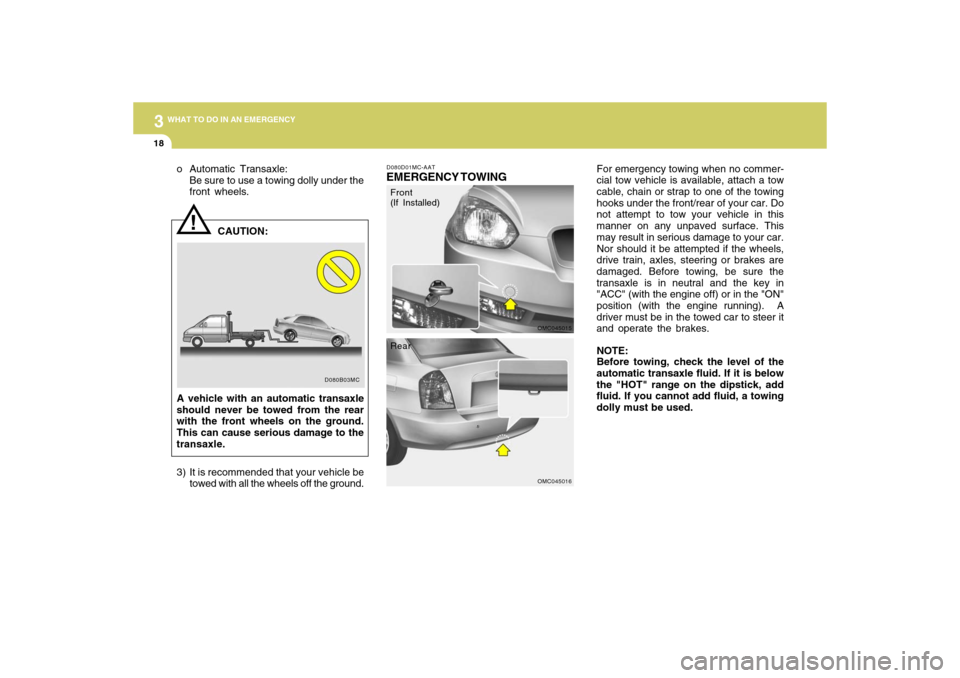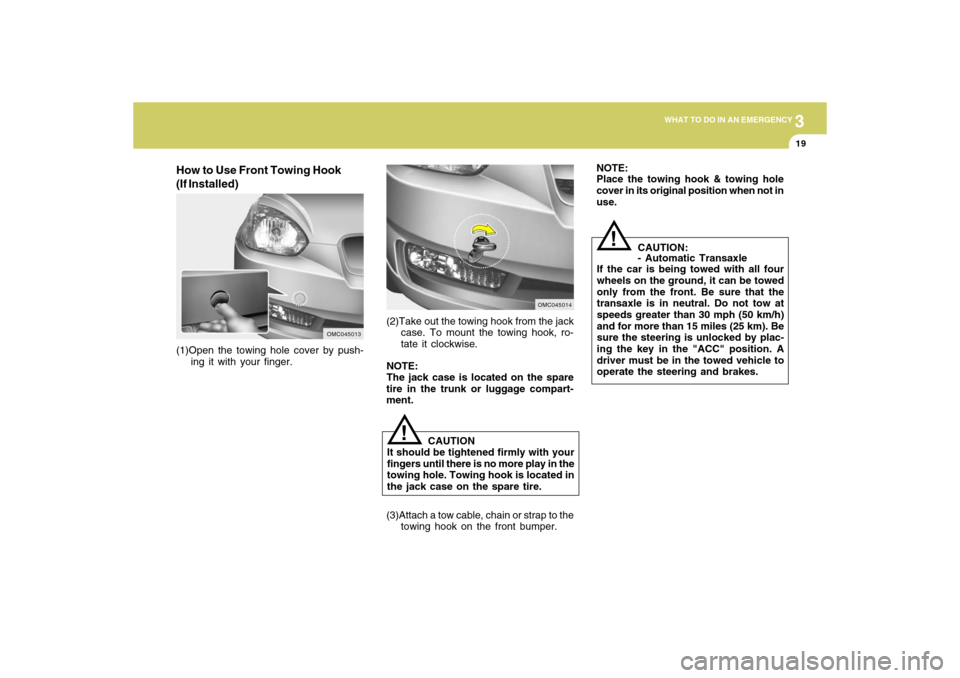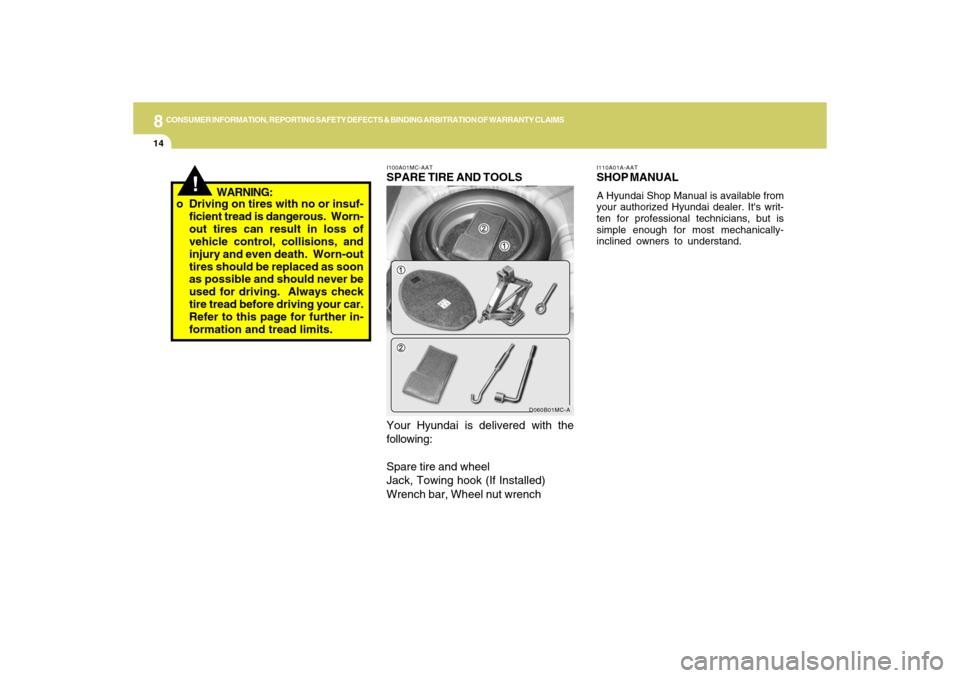2009 Hyundai Accent towing
[x] Cancel search: towingPage 186 of 266

318
WHAT TO DO IN AN EMERGENCY
D080D01MC-AATEMERGENCY TOWING
For emergency towing when no commer-
cial tow vehicle is available, attach a tow
cable, chain or strap to one of the towing
hooks under the front/rear of your car. Do
not attempt to tow your vehicle in this
manner on any unpaved surface. This
may result in serious damage to your car.
Nor should it be attempted if the wheels,
drive train, axles, steering or brakes are
damaged. Before towing, be sure the
transaxle is in neutral and the key in
"ACC" (with the engine off) or in the "ON"
position (with the engine running). A
driver must be in the towed car to steer it
and operate the brakes.
NOTE:
Before towing, check the level of the
automatic transaxle fluid. If it is below
the "HOT" range on the dipstick, add
fluid. If you cannot add fluid, a towing
dolly must be used.
OMC045015OMC045016
!
D080B03MC
CAUTION: o Automatic Transaxle:
Be sure to use a towing dolly under the
front wheels.
A vehicle with an automatic transaxle
should never be towed from the rear
with the front wheels on the ground.
This can cause serious damage to the
transaxle.
3) It is recommended that your vehicle be
towed with all the wheels off the ground.
Front
(If Installed)
Rear
Page 187 of 266

3
WHAT TO DO IN AN EMERGENCY
19
CAUTION:
- Automatic Transaxle
If the car is being towed with all four
wheels on the ground, it can be towed
only from the front. Be sure that the
transaxle is in neutral. Do not tow at
speeds greater than 30 mph (50 km/h)
and for more than 15 miles (25 km). Be
sure the steering is unlocked by plac-
ing the key in the "ACC" position. A
driver must be in the towed vehicle to
operate the steering and brakes.
!
OMC045013
OMC045014
(1)Open the towing hole cover by push-
ing it with your finger.(2)Take out the towing hook from the jack
case. To mount the towing hook, ro-
tate it clockwise.
NOTE:
The jack case is located on the spare
tire in the trunk or luggage compart-
ment.
!
CAUTION
It should be tightened firmly with your
fingers until there is no more play in the
towing hole. Towing hook is located in
the jack case on the spare tire.
How to Use Front Towing Hook
(If Installed)
NOTE:
Place the towing hook & towing hole
cover in its original position when not in
use.
(3)Attach a tow cable, chain or strap to the
towing hook on the front bumper.
Page 201 of 266

5
VEHICLE MAINTENANCE REQUIREMENTS6
DRIVING
CONDITION MAINTENANCE
INTERVALS
ENGINE OIL AND FILTER
AIR CLEANER FILTER
SPARK PLUGS
BRAKE PADS, CALIPERS AND ROTORS
REAR BRAKE DRUMS/LININGS,
PARKING BRAKE
STEERING GEAR BOX, LINKAGE
& BOOTS/LOWER ARM BALL JOINT
DRIVESHAFTS AND BOOTS
TIMING BELT
MANUAL TRANSAXLE OIL
AUTOMATIC TRANSAXLE FLUID
CLIMATE CONTROL AIR FILTER
R
R
R
I
I
I
I
R
R
R
R MAINTENANCE
OPERATION MAINTENANCE ITEM
EVERY 3,000 MILES (4,800 KM) OR 3 MONTHS
MORE FREQUENTLY
MORE FREQUENTLY
MORE FREQUENTLY
MORE FREQUENTLY
MORE FREQUENTLY
EVERY 7,500 MILES (12,000 KM) OR 6 MONTHS
EVERY 37,500 MILES (60,000 KM) OR 48 MONTHS
EVERY 60,000 MILES (96,000 KM)
EVERY 30,000 MILES (48,000 KM)
MORE FREQUENTLY
SEVERE DRIVING CONDITIONSA - Repeatedly driving short distance of less than 5miles (8km) in normal
temperature or less than 10miles (16km) in freezing temperature
B - Extensive engine idling or low speed driving for long distances
C - Driving on rough, dusty, muddy, unpaved, graveled or salt- spread roads
D - Driving in areas using salt or other corrosive materials or in very cold
weatherE - Driving in sandy areas
F - Driving in heavy traffic area over 90°F (32°C)
G - Driving on uphill, downhill, or mountain road
H - Towing a Trailer, or using a camper, or roof rack
I - Driving as a patrol car, taxi, other commercial use or vehicle
towing
J - Driving over 100 MPH (170 Km/h)
K - Frequently driving in stop-and-go conditionsA, B, C, D, E, F, G, H, I, K
C, E
B, H
C, D, G, H
C, D, G, H
C, D, E, F, G, H, I
C, E, F
B, C, D, E, F, G
A, C, D, E, F, G, H, I, J
A, C, E, F, G, H, I
C, EMAINTENANCE UNDER SEVERE USAGE CONDITIONSF040A02MC-AATThe following items must be serviced more frequently on cars normally used under severe driving conditions. Refer to the chart below
for the appropriate maintenance intervals.
R : Replace I : Inspect and, after inspection, clean, adjust, repair or replace if necessary
Page 252 of 266

8
CONSUMER INFORMATION, REPORTING SAFETY DEFECTS & BINDING ARBITRATION OF WARRANTY CLAIMS
14
!
WARNING:
I100A01MC-AATSPARE TIRE AND TOOLS
Your Hyundai is delivered with the
following:
Spare tire and wheel
Jack, Towing hook (If Installed)
Wrench bar, Wheel nut wrench
I110A01A-AATSHOP MANUALA Hyundai Shop Manual is available from
your authorized Hyundai dealer. It's writ-
ten for professional technicians, but is
simple enough for most mechanically-
inclined owners to understand.
D060B01MC-A
o Driving on tires with no or insuf-
ficient tread is dangerous. Worn-
out tires can result in loss of
vehicle control, collisions, and
injury and even death. Worn-out
tires should be replaced as soon
as possible and should never be
used for driving. Always check
tire tread before driving your car.
Refer to this page for further in-
formation and tread limits.
Page 265 of 266

10
INDEX
5
R
Rear Seat
Folding rear seatbacks ...................................................1-19
Warning...........................................................................1-22
Rear Window Defroster Switch .........................................1-81
Reporting Safety Defects ...................................................8-18
S
Seats ...................................................................................1-13
Front ................................................................................1-14
Rear.................................................................................1-18
Seat Belts ...........................................................................1-22
3-Point system ................................................................1-26
Adjusting your seat belt ..................................................1-28
Care of seat belts ...........................................................1-25
Pre-tensioner seat belt ...................................................1-39
Precautions.....................................................................1-22
Speedometer......................................................................1-71
Starting Procedure ............................................................... 2-5
Steering Wheel Tilt Lever ................................................1-101
Stereo Sound System ......................................................1-117
Sun Visor ............................................................................1-99
Sunglass Holder ................................................................1-88
Sunroof...............................................................................1-84T
Tachometer.........................................................................1-70
Theft-Alarm System .............................................................. 1-8
Tire Pressure Monitoring System (TPMS) ........................... 3-5
Tires
All season tires ...............................................................8-10
Balancing........................................................................8-12
Chains.............................................................................8-10
Changing a flat tire .........................................................3-11
Checking the inflation pressure ....................................... 8-5
If you have a flat tire .......................................................3-11
Information........................................................................ 8-3
Maintenance...................................................................8-13
Pressure............................................................................ 8-3
Replacement...................................................................8-12
Rotation...........................................................................8-11
Sidewall labeling.............................................................. 8-6
Snow tires .......................................................................8-10
Spare tire ........................................................................3-10
Terminology and definitions ............................................. 8-8
Traction...........................................................................8-12
Towing
A trailer (or vehicle) ........................................................2-20
Emergency......................................................................3-18
If your vehicle must be towed ........................................3-16